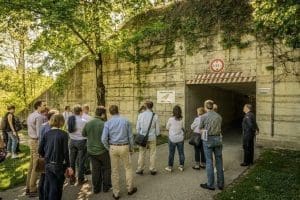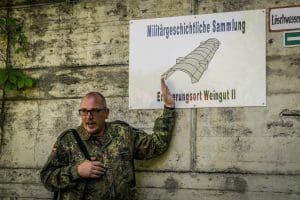

The Welfenkaserne is a barracks of the Bundeswehr in Landsberg on the Lech in the state of Bavaria. In the barracks there is an underground facility (UTA), which had to be erected by concentration camp prisoners at the end of the Second World War . It now houses the repair center 13 and parts of the Bundeswehr service center Landsberg am Lech. The area comes with a lot of history… it was a German bomber production plant in World War 2 that was built by prisoners from the neighboring concentration camp that housed Hungarian Jews. After the War, the camp housed German refugees that were being relocated the Eastern Countries. The American military even used the bunkers for a while in the 70s. Today, the buildings are used by the German Bundeswehr (Army), who have also created a memorial at the site to respect the past.
Michael Graber (our Motorcycle Tour guide) was able to take a tour of the facility, and kindly shared his photos and some information about the site. Thank you Michael for sharing this important piece of history with us.
A Visit to Welfen Kaserne Landesberg written by Michael Graber

I booked a visit of the so-called “Weingut II” at the VHS (Volkshochschule) Landsberg. This was a production plant commissioned by the Nazis for the first jet fighter in the world, the Messerschmidt Me 262. After most bomber aircraft had been destroyed by Allied bombs in Germany, Albert Speer was commissioned by Hitler to stop the relocation Production in decentralized places, primarily in new large-scale bunkers. From former 27 large factories, everything was moved to 729 smaller sites, which where more difficult to eliminate.
One of these giant bunkers was developed at Landsberg. It was planned to build a gigantic structure of 400 m length, 86 m width and 27 m height. The thickness of the upper concrete cover was 5 meters and thus withstood the heaviest bombs of the Allies. When the Americans freed Landsberg on April 21, 1945, the construction work had been stopped a few days before. Of the 400 m length, however, approx. 230 m had already been completed. The rest was a huge construction site.
The workers on the construction site were concentration camp prisoners. It was mostly Hungarian Jews – precisely those who had been deported to Auschwitz in the course of the extermination of Hungarian Jewry from the middle of 1944, and had been selected as “working” on the “ramp”! Thus, 23,000 Jews from Budapest and other cities came to lodge in several accommodation camps near Landsberg, where they had to live under the most miserable conditions. During the construction of the monstrous bunker about 6,600 of these Hungarian Jews were killed.
After the Second World War, the bunker was first to be demolished, but due to the size of the building it would have required an atomic bomb of the Hiroshima type. The Americans finally stored their own bombs in “Weingut II” until the early 1960s -Jahre. Franz-Josef Strauss shouted “Hurra”, as a new carrier rocket for nuclear weapons (“Matador” system) should be installed in Germany. The unfinished “Weingut II” bunker was chosen as a warehouse for this weapon system. They built another bunker under the outer cover of the old bunker (bunker in the bunker). The plant would now have a direct hit of an atomic rocket. However as fate would have it, the Matador system was never implemented. Instead, the “Pershing 1” rocket was deployment was dispersed. There were therefore spent billions for nothing.
Today the Welfen-Barracks of the Bundeswehr are located on the grounds around “Weingut II”. The bunkers system is used by a maintenance and repair unit. Electronic devices of the Luftwaffe are now being repaired. What is so special about this place is that the Bundeswehr, on its own initiative, took the bunker to use as a place of remembrance. The Bundeswehr has even set up a museum and a memorial in a bunker hall. Groups and individuals can book a guided tour.
Same story in the Original German
Ich habe eine Besichtigung des so genannten “Weingut II” bei der VHS (Volkshochschule) Landsberg gebucht. Dabei handelte es sich um eine von den Nazis in Auftrag gegebene Produktionsstätte für den ersten Düsenjäger der Welt, die Messerschmidt Me 262. Nachdem die meisten zentralen Flugzeugfabriken in Deutschland durch Bombenangriffe der Alliierten zerstört worden waren, wurde Albert Speer von Hitler beauftragt, die Verlagerung der Produktion in dezentrale Orte, vorrangig in neu zu errichtende Großbunker, zu organisieren. Von ehemals 27 Großfabriken wurde alles in 729 kleinere Standorte verlegt, die kaum auszuschalten waren.
Einer dieser Riesenbunker sollte bei Landsberg entstehen. Es war geplant, ein gigantisches Bauwerk von 400 m Länge, 86 m Breite und 27 m Höhe zu errichten. Die Dicke der oberen Betonabdeckung betrug 5 m und hätte damit den schwersten Bomben der Alliierten widerstanden.
Als die Amerikaner am 21. April 1945 Landsberg befreiten, waren die Bauarbeiten ein paar Tage vorher eingestellt worden. Von den 400 m Länge waren jedoch bereits ca. 230 m fertig gestellt worden. Der Rest war eine riesige Baustelle.
Die Arbeitskräfte auf der Baustelle waren – wie leicht zu vermuten – KZ-Häftlinge. Es handelte sich überwiegend um ungarische Juden – eben jene, die im Verlauf der Vernichtung der ungarischen Judentums ab Mitte 1944 nach Auschwitz deportiert und an der “Rampe” als arbeitsfähig selektiert worden waren! So kamen 23.000 Juden aus Budapest und anderen Städten in mehreren Unterkunftslagern in der Nähe von Landsberg unter, wo sie unter erbärmlichsten Bedingungen hausen mussten. Beim Bau des monströsen Bunkers sind ca. 6.600 dieser ungarischen Juden ums Leben gekommen.
Nach dem 2. Weltkrieg sollte der Bunker erst gesprengt werden, was aber aufgrund der Dimensionen des Bauwerks noch mal eine Atombombe des Hiroshima-Typs erfordert hätte … Die Amerikaner lagerten schließlich ihre eigenen Bombenvorräte in “Weingut II” ein, bis Anfang der 60er-Jahre Franz-Josef Strauss “Hurra” schrie, als eine neue Trägerrakete für Atomwaffen (“Matador”-System) in Deutschland installiert werden sollte. Als Lager für dieses Waffensystem wurde der unfertige “Weingut II”-Bunker auserkoren. Man baute dann unter die Außenhülle des alten Bunkers einen weiteren Bunker ein (Bunker im Bunker). Die Anlage hätte jetzt einen direkten Treffer einer Atomrakete ausgehalten. Wie es das Schicksal wollte, wurde das Matador-System aber nie implementiert. Statt dessen schwenkte man auf die “Pershing 1”-Rakete um, die dezentral eingelagert wurde. Es wurden also Abermillionen umsonst ausgegeben.
Heute befindet sich auf dem Gelände um “Weingut II” die Welfen-Kaserne der Bundeswehr. Das Bunkersystem wird von einer Wartungs- und Instandsetzungseinheit genutzt. Es werden jetzt elektronische Geräte der Luftwaffe repariert.
Das Besondere an diesem Ort ist nun, dass die Bundeswehr von sich aus den Bunker einer weiteren Nutzung als Erinnerungsort zugeführt hat. Die BW hat sogar ein Museum und eine Gedenkstätte in einer Bunkerhalle eingerichtet. Es können sowohl Gruppen, als auch Einzelpersonen eine Führung buchen.
For more information about the Welfenkaserne…click here–>
https://de.wikipedia.org/wiki/Welfenkaserne
For More Information about the Landsberger Holocaust Memorial… click here–>
http://www.landsberger-zeitgeschichte.de/Gedenkstaette.htm
Click this link to see all of Michaels photos. Please don’t download them for your use without asking Michael for permission.
https://www.flickr.com/photos/michael_g2010/sets/72157680842510834/
 Thank you again Michael for sharing this tour with us. You’ve given us all a chance to see a seldom visited part of Germany.
Thank you again Michael for sharing this tour with us. You’ve given us all a chance to see a seldom visited part of Germany.












